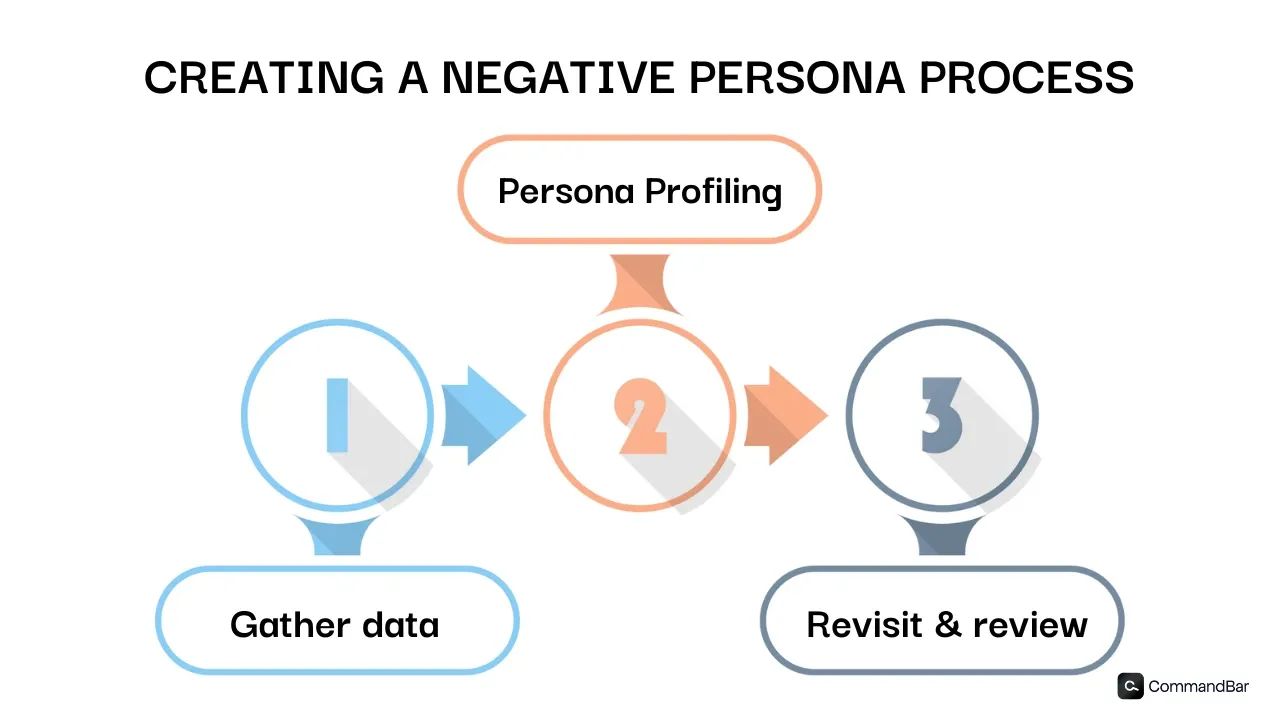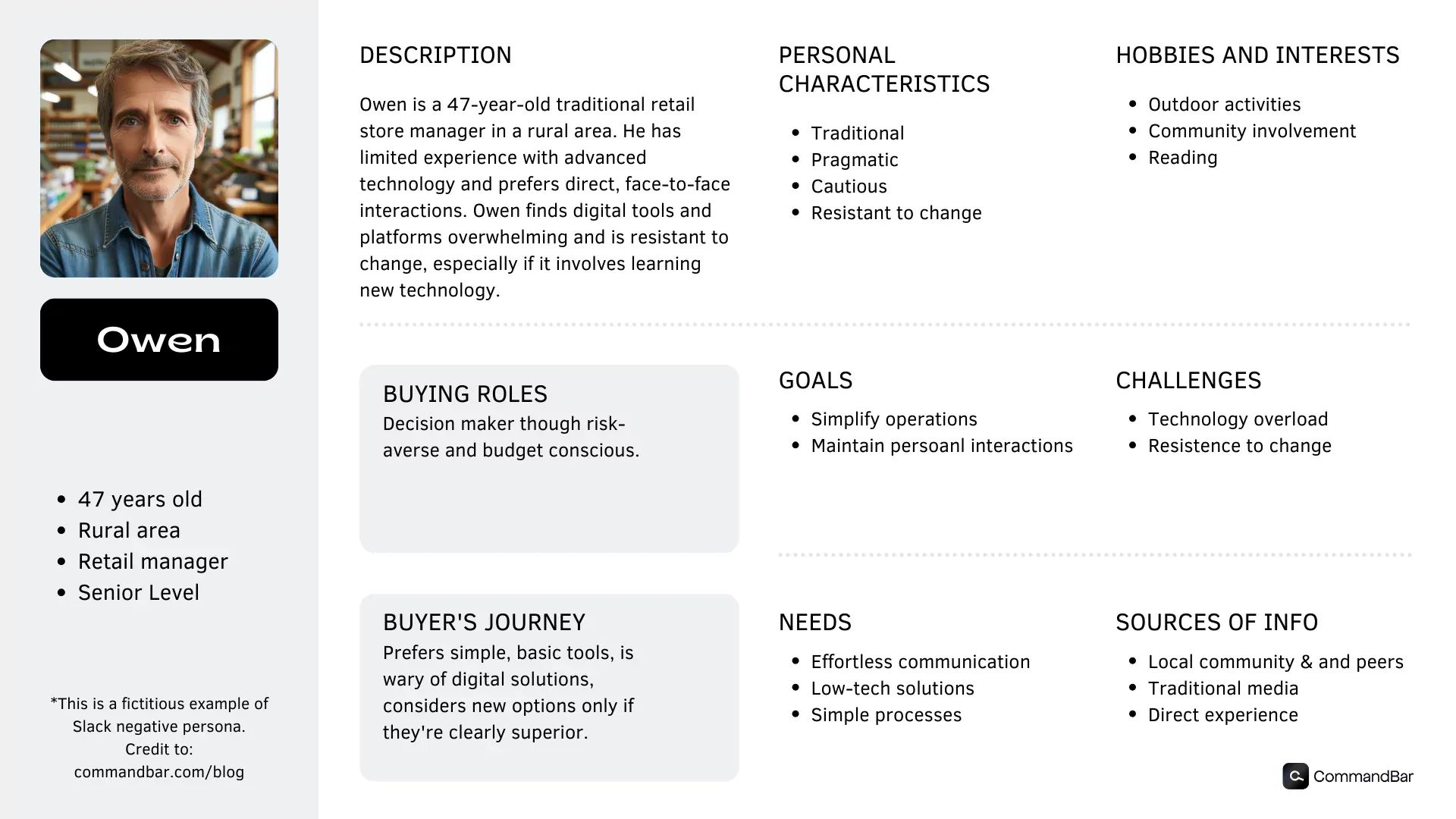Why should you create a negative persona?
A step-by-step guide on creating negative personas. An essential strategy for focusing on your ideal customers and optimizing resources.

If I told you to close your eyes and absolutely do not under any circumstances imagine a pink elephant, what immediately pops into your head when your eyes shut? A pink elephant.
We are wired to focus on what we pay attention to.
The rules of product marketing are no different. When it comes to ideal customer avatars, you should create a negative persona as soon as possible to help you focus your efforts on attracting the perfect users into your product (while avoiding appealing to the wrong crowd).
In this article, I’m going to walk you through:
- What is a negative persona
- Why creating a negative persona is important
- How to create a negative persona
What is a negative persona?
A negative persona is a semi-fictional representation of the type of customer you don’t want in your product. A negative persona is an archetype of someone who might meet some or all of these qualities:
- Can’t afford or doesn’t see the value in your product
- Is difficult to work with
- Has needs you can’t meet
- Lacks the skills or resources to utilize your product
- Geographically restricted or limited
- Creates an adverse impact on your brand image
Sounds pretty grim, doesn’t it?
Not unlike your ideal customer avatars, negative personas are generally made up of (though not limited to):
- Basic bio
- Personality traits
- Lifestyle choices
- Intrinsic motivations
- Buying habits
- Career and financial info
Personas are typically created by marketing and or product teams. The end result should look like a descriptive, informative resource outlining a holistic view of a (fictitious) person as it relates to your product or company. In other words, a clearly defined avoid-this-type-of-person-at-all-costs bullseye to ignore.
Why are negative personas important?
Negative personas are important for a number of reasons, though they become particularly critical when strategizing marketing and product growth objectives. Here are some of the common upsides of creating a negative persona.
Conserving resources
Whether you’re a startup or a part of a tiny cog in a giant corporation, no one wants to burn through resources unnecessarily (said no VC ever.) Jokes aside, time and resources are often finite. If you’re not explicit about the negative persona you’re avoiding, you’re likely hemorrhaging resources by appealing to them. Inevitably, this wasted energy could be your ball and chain that the competition capitalizes on.
Improve marketing potency
Typically, one of the first cost centers to be culled as companies start to hit financial trouble is marketing. As a marketer myself, this doesn’t have me sleeping easy at night, trust me. So, as a heads up to all my fellow product marketers out there, heed this little insight - dialing in your negative persona is going to dramatically increase the potency of your marketing efforts.
Anytime your negative persona sees or hears anything about your product, it should send shivers down their spine - repulse them, in fact. By shunning the people you don’t want in your product, you’re inevitably opening the door to the people you’re trying to appeal to.
Optimize product development
You’ve probably heard the saying, “The squeaky wheel gets the oil.” The implication is that the ones who make the most noise get all the support and attention. In product development, it’s healthy to look out for user friction, complaints, and feature requests; that’s user feedback 101. But if you’re listening to feedback from users who fall into your negative persona category, you’re setting yourself up for a world of hurt.
Imagine building a bunch of features and products to appease a segment of the market that makes your life a misery. That doesn’t sound fun at all.
Making sure you’ve clearly defined and constantly revisited your negative persona when developing products is critical to stable and consistent growth.
Better customer experience
Piggybacking off the product development thread above, if your features and overall user experience cater to users who land in your negative persona bucket, you’re going to be making your ideal customers really unhappy.
By prioritizing features that your ideal customers don’t want, need, or care about, you risk creating a terrible customer experience, leading to a bunch of churn.
How to create a negative persona
The process for creating a negative persona is simple and easy to follow. There are three phases in the sequence, and it’s best to revisit your negative persona as your company evolves to make sure you’re still in alignment with the direction you’re heading in.

Gather data
The first phase of creating a negative persona is collecting all the information. It’s time to dust off the magnifying glass and dig into the weeds. In light of making the most accurate version of your negative persona, you’re going to want to source from a wide context.
- Review customer data: Analyze existing users and look out for reasons and patterns among those who weren’t a good fit or who churned.
- Get feedback from the team: Chat with sales, marketing, customer service, and product etc. What can they share with you about users who were challenging or not a good match?
- Analyze feedback and reviews: Look into negative feedback or reviews from users. Consider formal tools like G2 and also discussions on platforms like Reddit, X, HackerNews, etc.
- Identify demographic traits: Don’t overlook demographic and behavioral insights either (age, location, income, lifestyle, interests, etc.) These are going to be very critical in helping you shape a vivid negative persona.
Persona profiling
So you’re sitting there with a corpus of notes, interviews, tidbits, insights, and scribblings covering every possible reason why a user wasn’t a fit for your product and why they churned.
What do you do now? If you’ve seen any episode of Law & Order, you know it’s time to compile your research into a profile (or, in this case, a negative persona).
- Segment the data into categories like demographics, pain points, and product feedback.
- Identify patterns like common characteristics and reasons for churning.
- Summarize your findings into a succinct negative persona resource.
- Add contextual details like specific scenarios or verbatim quotes.
- Narrate a clear story arc across the negative persona.
In the end, you should have a resource that looks like this (note, this is an example I made up for Slack):

Slack’s negative persona: Overwhelmed Owen
Basic Information:
- Name: Owen
- Age: 47
- Occupation: Traditional Retail Store Manager
- Location: Rural Area
Demographics:
- Owen manages a small, local retail store in a rural area.
- He has limited experience with technology and prefers face-to-face interactions.
Behavioral Traits:
- Owen finds technology overwhelming and prefers traditional methods of communication, like phone calls and in-person meetings.
- He is resistant to adopting new software, especially if it seems complex.
Pain Points:
- Owen feels that tools like Slack complicate simple communication processes.
- He is uncomfortable with the rapid pace of digital messages and prefers more deliberate communication.
- The array of features in Slack, like channels and integrations, seems excessive for his needs.
Technology Use:
- Limited use of technology in his work. Primarily uses email and basic office software.
- Prefers straightforward, user-friendly solutions with a minimal learning curve.
Attitude Towards Slack:
- Views Slack as overly complicated for his business needs.
- Believes that Slack's features are more suited to tech-savvy users or larger, more digitally-oriented businesses.
- Finds the transition from traditional communication methods to Slack challenging and unnecessary for his team's dynamics.
Revisit & review
Well done, creating a negative persona is no mean feat. But unfortunately, the fun doesn’t stop here. As your company grows, products change, missions expand, or contract, it’s important to revisit your negative persona intermittently.
As your company grows, so too will the breadth of user segments. At scale, you may find that you’ll end up with more than one negative persona, depending on your product stack. Simply follow the same process for each user group as it relates to your product.
Wrapping up
It might feel uncomfortable sifting through the bowels of feedback and pulling out the worst insights as to why someone wasn’t a fit or why they churned. But honestly, this cathartic experience will pay off dividends when you create your negative persona.
Being scrupulous about who you’re not appealing to will naturally conserve your resources, refine your marketing, streamline product development, and improve overall user experience.
This is your sign to create your negative persona.
